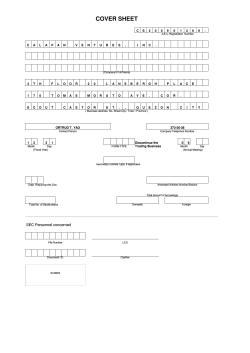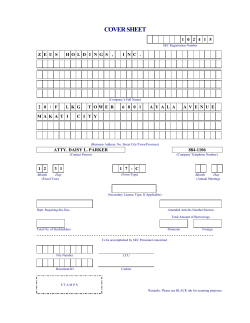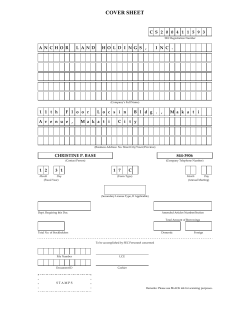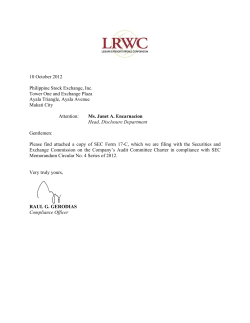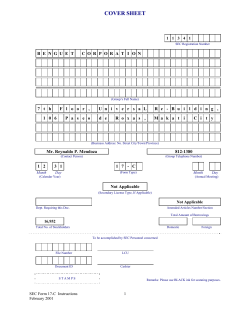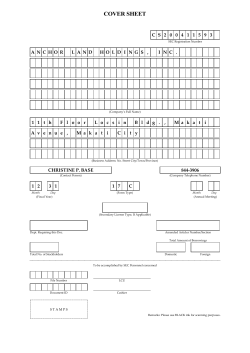
Chapter 4: Sample Questions, Problems and Solutions Örnek Sorular (Sample Questions):
Chapter 4: Sample Questions, Problems and Solutions Bölüm 4: Örnek Sorular, Problemler ve Çözümleri Örnek Sorular (Sample Questions): • What are broadcast channels or multi-access channels or random access channels? • What is a function of MAC (Medium Access Control) sublayer? • Which are the static channel allocation methods? • What are the lacks of the static channel allocation methods? • What is a pure ALOHA protocol? • What is a slotted ALOHA protocol? • What is a contention system? • What are Persistent and Nonpersistent CSMA (Carrier Sense Multiple Access) protocols? • What is CSMA/CD (Carrier Sense Multiple Access with Collision Detection) protocol? • What is a Collision-Free protocol? • What is a Bit Map protocol? • What is a Binary Countdown protocol? • What is a Limited-Contention protocol? • What is an Adaptive Tree Walk Protocol? • What is a Wavelength Division Multiple Access Protocols? • What is MACA (Multiple Access with Collision Avoidance)? • What is MACA for Wireless (MACAW)? • What are IEEE 802.11 Services? • What is a Broadband Wireless? • What is a IEEE 802.16 Protocol Stack? • The IEEE 802.16 Physical Layer • What is the IEEE 802.16 MAC Sublayer protocol? • What is the IEEE 802.16 Frame Structure? • What is a BLUETOOTH? • What is an IEEE 802.15 Protocol Stack? • What is the IEEE 802.15 Frame Structure? • What is a Bridge? • Bridges from 802.x to 802.y • Local Internetworking • Spanning Tree Bridges • Remote Bridges • What are Repeaters? • What are Hubs? • What are Switches? • What are Routers? • What are Gateways? • What are Virtual LANs? • What is the IEEE 802.1Q Standard? Örnek Problemler ve Çözümleri (Sample Problems and Solutions): (Chapter 4, Problem 2-1) A group of N stations shares a 56-kbps pure ALOHA channel. Each station outputs a 1000-bit frame on an average of once every 100 sec, even if the previous one has not yet been sent (e.g., the stations can buffer outgoing frames). What is the maximum value of N? ANS: With pure ALOHA the usable bandwidth is 0.184x56 kbs=10.3 kbps. Each station requires 10 bps, so N=10300/10=1030 stations. (Chapter 4, Problem 4) 1000 airline reservation stations are competing for the use of a single slotted ALOHA channel. The average station makes 36 requests per hour. A slot is 100 µsec. What is the approximate total channel load? ANS: Each terminal makes one request every 3600 sec / 36 request = 100 sec. Total load is 1000 requests per 100 sec or 10 requests per sec. There are 1 sec/100 µsec = 1000000 µsec / 100 µsec = 10000 slots in one second. Hence, G=10/10000=1/1000=0.1% (Chapter 4, Problem 7.1) Sketch and describe the operation of a LAN bridge from 802.11 to 802.3. ANS: Host A on a wireless (802.11) LAN has a packet to send to a fixed host, B, on an (802.3) Ethernet to which the wireless LAN is connected. The packet descends into the LLC sublayer and acquires an LLC header (shown in black in the figure). Then it passes into the MAC sublayer and an 802.11 header is prepended to it (also a trailer, not shown in the figure). This unit goes out over the air and is picked up by the base station, which sees that it needs to go to the fixed Ethernet. When it hits the bridge connecting the 802.11 network to the 802.3 network, it starts in the physical layer and works its way upward. In the MAC sublayer in the bridge, the 802.11 header is stripped off. The bare packet (with LLC header) is then handed off to the LLC sublayer in the bridge. In this example, the packet is destined for an 802.3 LAN, so it works its way down the 802.3 side of the bridge and off it goes on the Ethernet. Note that a bridge connecting k different LANs will have k different MAC sublayers and k different physical layers, one for each type. (Chapter 4, Problem 10-1) Sixteen stations, numbered 1 through 16, are contending for the use of a shared channel by using the adaptive tree walk protocol. If all the stations whose addresses are odd numbers suddenly become ready at once, how many bit slots are needed to resolve the contention? ANS: Stations 1, 3, 5, 7, 9, 11, 13, and 15 want to send: Slot 1: 1, 3, 5, 7, 9, 11, 13, 15 Slot 2: 1, 3, 5, 7 Slot 3: 1, 3 Slot 4: 1 Slot 5: 3 Slot 6: 5, 7 Slot 7: 5 Slot 8: 7 Slot 9: 9, 11, 13, 15 Slot 10: 9, 11 Slot 11: 9 Slot 12: 11 Slot 13: 13, 15 Slot 14: 13 Slot 15: 15 15 bit slots are needed. (Chapter 4, Problem 10-2) Sixteen stations, numbered 1 through 16, are contending for the use of a shared channel by using the adaptive tree walk protocol. If stations 2, 6, 8, 11, and 15 suddenly become ready at once, how many bit slots are needed to resolve the contention? ANS: Stations 2, 6, 8, 11, and 15 want to send: Slot 1: 2, 6, 8, 11, 15 Slot 2: 2, 6, 8 Slot 3: 2 Slot 4: 6, 8 Slot 5: 6 Slot 6: 8 Slot 7: 11, 15 Slot 8: 11 Slot 9: 15 9 bit slots are needed. (Chapter 4, Problem 16-1) What is the baud rate of the standard 10-Mbps Ethernet which uses Manchester encoding? ANS: The Ethernet uses Manchester encoding, which means it has two signal periods per bit sent. The data rate of the standard Ethernet is 10 Mbps, so the baud rate is twice that, 20 Megabaud. (Chapter 4, Problem 16-2) What is the baud rate of the Gigabit Ethernet which uses Manchester encoding? ANS: The Ethernet uses Manchester encoding, which means it has two signal periods per bit sent. The data rate of the Gigabit Ethernet is 1Gbps, so the baud rate is twice that, 1Gigabaud. (Chapter 4, Problem 17) Sketch the Manchester encoding for the bit stream: 1010110000110100 ANS: Bit Stream: Binary Encod. Manch. Encod. 1 0 1 0 1 1 0 0 0 0 1 1 0 1 0 0 (Chapter 4, Problem 19) A 1-km-long, 10-Mbps CSMA/CD (Carrier Sense Multiple Access with Collision Detection) LAN (not 802.3) has a propagation speed of 200 m/µsec. Repeaters are not allowed in this system. Data frames are 256 bits long, including 32 bits of header, checksum, and other overhead. The first bit slot after a successful transmission is reserved for the receiver to capture the channel in order to send a 32-bit acknowledgement frame. What is the effective data rate, excluding overhead, assuming that there are no collisions? ANS: The round-trip propagation time of the cable is 10 µ sec . A complete transmission has six phases: 1) Transmitter seizes cable (10 µ sec ) 2) Transmit data (25.6 µ sec ) 3) Delay for last bit to get to the end (5.0 µ sec ) 4) Receiver seizes cable (10 µ sec ) 5) Acknowledgement sent (3.2 µ sec ) 6) Delay for last bit to get to the end (5.0 µ sec ) The sum of these is 58.8 µ sec . In this period, 224 data bits are sent, for a rate of about 3.8 Mbps. (Chapter 4, Problem 21-1) Consider building a CSMA/CA (Carrier Sense Multiple Access with Collision Detection) network running at 1 Gbps over a 1-km cable with no repeaters. The signal speed in the cable is 200,000 km/sec. What is the minimum frame size? ANS: For a 1-km cable, the one-way propagation time is 5 µ sec , so 2τ = 10 µ sec . To make CSMA/CD work, it must be impossible to transmit an entire frame in this interval. At 1 Gbps, all frames shorter than 10,000 bits can be completely transmitted in under 10 µ sec , so the minimum frame is 10,000 bits or 1250 bytes. (Chapter 4, Problem 21-2) Consider building a CSMA/CD network running at 10 Gbps over a 2.5-km cable with no repeaters. The signal speed in the cable is 200,000 km/sec. What is the minimum frame size? ANS: For 2.5-km cable, the one–way propagation time τ=12.5 µ sec , so 2τ=25 µ sec . At 10 Gbps, 250,000 bits can be completely transmitted in under 25 µ sec . So minimum frame is 250,000 bits or 3125 bytes. (Chapter 4, Problem 30) An 802.16 network has a channel width of 10 MHz. How many bits/sec can be sent to a subscriber station? (Evaluate for QAM-64, QAM-16 and QPSK methods). ANS: It depends how far away subscriber is. If the subscriber is close in, QAM-64 is used for 60 Mbps. For medium distance, QAM-16 is used for 40 Mbps. For distant stations, QPSK is used for 20 Mbps. (Chapter 4, Pages 326-327) Define which devices are in which layers and give a short definition for each of them. ANS: (Chapter 4, Problem 40) A switch designed for use with fast Ethernet has a backplane that can move 10 Gbps. How many frames/sec can it handle in the worst case? Hint: the worst case is an endless stream of 64-byte frames. ANS: The worst case is an endless stream of 64-byte 64 byte = 512 bits frames. If the backplane can handle 10 Gbps = 109 bps. The number of frames it can handle is 109 bit / 512 bit This is 1,953,125 frames / sec. (Chapter 4) There are 4 contention slots. In 1st cycle of frame transmition the stations 1 and 3, in the 2nd cycle of frame transmition the station 0 and 2, in the 3rd cycle of frame transmition the station 3 and in the 4th cycle of frame transmition all stations have frames to send. Sketch these cycles for the basic bit-map protocol. ANS: Cycles: 1st cycle Slots: 0 1 2 3 Frames: 1 1 F1 F3 F3 2nd cycle 0 1 2 3 1 1 F0 F2 3rd cycle 0 1 2 3 1 F3 4th cycle 0 1 2 3 1 1 1 1 F0 F1 F2 (Chapter 4) Given 8 stations and their data to send using single channel. Find the number of station and data sent. Use binary countdown protocol. ANS: Station 1 Station 2 Station 3 Station 4 Station 5 Station 6 Station 7 Station 8 0 1 0 1 1 0 1 0 1 1 0 1 1 0 0 0 0 0 0 1 1 0 1 1 1 0 1 0 1 0 1 1 0 1 1 0 0 1 1 0 1 1 1 0 1 0 1 0 0 0 0 1 0 1 0 1 1 0 1 0 1 0 0 1 The 5th station sends the data 11110101 0 0 1 0 1 1 0 1 0 1 Bit time 2 3 4 5 1 0 1 1 1 1 0 0 1 0 1 6 7 0 1 (Chapter 4) A LAN uses Mok and Ward’s version of binary countdown. At a certain instant, the ten stations have the virtual station numbers 8, 2, 4, 5, 1, 7, 3, 6, 9, and 0. The next three stations to send are 4, 3, and 9, in that order. What are the new virtual station numbers after all three have finished their transmissions? ANS: Initial virtual station numbers are: 8 2 4 5 1 7 3 6 9 0 When station 4 sends, it becomes 0, and 0, 1, 2, 3 are increased by 1. 8 3 0 5 2 7 4 6 9 1 When station 3 sends, it becomes 0, and 0, 1, 2, 3 are increased by 1. 8 0 1 5 3 7 4 6 9 2 Finally, when station 9 sends, it becomes 0 and all the other stations are incremented by 1. The result is 9 1 2 6 4 8 5 7 0 3 (Chapter 4) Sketch the differential Manchester encoding for the bit stream 0001110101. Assume the line is initially in low state. ANS: HLHL HLLH HLL HLH HLHL LH
© Copyright 2025


